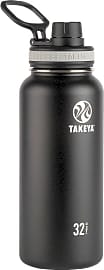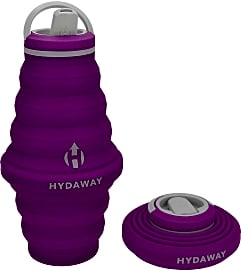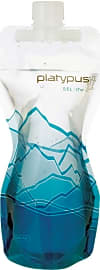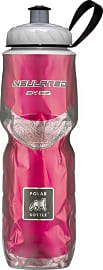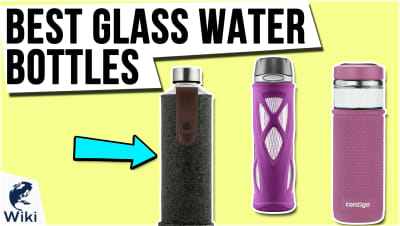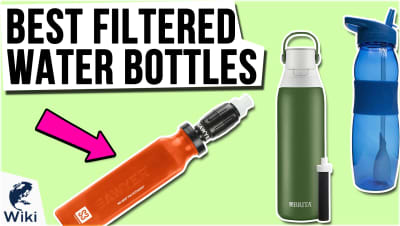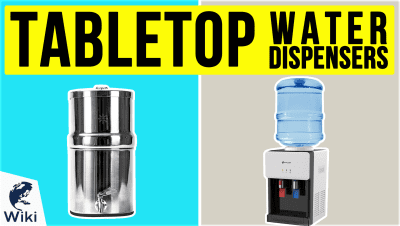The 10 Best Water Bottles

This wiki has been updated 40 times since it was first published in March of 2015. A reusable water bottle is much better for the environment than disposable plastic ones and, in many cases, much more stylish, too. Keep yourself healthily hydrated with one of our choices, which include models for just about every lifestyle. They are available in BPA-free plastic, stainless steel and glass with varying capacities to suit all needs. When users buy our independently chosen editorial recommendations, we may earn commissions to help fund the Wiki.
Editor's Notes
January 12, 2020:
Even though we liked its eye-catching design, we have ultimately opted to remove the Embrava Best Sports, as it may develop leaks over time — never a good thing for a bottle that claims to work for adventurers and athletes. But we kept the Lifefactory 22-Ounce, even though it isn't made to be entirely spill-proof, since it is advertised as such; consider this glass water bottle for carrying from your home to the office and back, rather than for tossing in your bag for travel. We also chose to remove the CamelBak Chute, as the redesigned version has a lid that many find just too hard to open. If you'd like a bottle with a spout-type lid, you might consider the Takeya Originals or Thermos Nissan Intak, instead. Note, however, that the Intak's lid can break when dropped.
On the more portable side of things, we kept the Nomader Collapsible and added the Hydaway 25 Ounce. These are both made from silicone, which smells plasticky to some users. If you're very sensitive to such smells, these models might not be your best option. On the other hand, they weigh little and don't take up much space, making them excellent for those on the go. And, finally, when it comes to top choices, it remains hard to beat the classic Hydro Flask Vacuum Insulated and the Nalgene Tritan Narrow Mouth. The former is a stainless steel model that is made for the long haul, while the latter offers BPA-free Eastman Tritan polycarbonate. The Hydro Flask has the wider mouth, so if you like to use a lot of standard ice cubes, it may be your better bet.
Special Honors
Larq Bottle Just one charge will give you up to a month of power for the Larq Bottle, which uses UV-C technology to purify not only the contents but also the bottle itself. A sleek and stylish choice, it powers on every two hours, so the water you drink remains fresh all day long. livelarq.com
Aarke Carbonator II Those who are tired of boring, still water will want to take a look at the Aarke Carbonator II, a kit that includes a beautifully designed carbonation machine and a simple screw-top water bottle. It's on the more expensive side, but it's compact, easy to use, and offered in several handsome colors. aarke-usa.com
The Bottle by LifeFuels The Bottle by LifeFuels bills itself as a smart nutrition bottle, as it holds the company's FuelPods and dispenses nutrient-packed flavoring from them with just a touch — whether that's on the bottle itself or via the app. It keeps track of how much you drink throughout the day, and comes with everything you need to get started, including a charging cable and cleaning brush. lifefuels.com
All Shriveled Up, Or Not?
If your blood sugar levels get too high, your body will produce more urine to try to return to homeostasis, which, in turn, dehydrates you.
If you’re considering making an investment in a water bottle, chances are good that you don’t think you currently keep yourself well enough hydrated. You’re not alone there, but the facts about your hydration may surprise you. It turns out, according to the US Nation Health Nutrition Examination Survey, that men average about 117 ounces of water daily (a little over 14 cups), and women consume a bit less, totaling about 93 ounces (almost 12 cups) each day.
So, if you’re worried about your hydration levels alone, you’re probably worried over nothing. The real problem, however, lies in the sources of our hydration. According to the same survey, only about 30 percent of a man’s hydration, and about 34 percent of a woman’s actually come from plain water.
Where does the rest of our hydration come from, then? Well, unfortunately, a lot of it comes from sodas, juices, energy drinks, and other forms of liquid sustenance that tend to be heavily laden with additives, including public enemy number one: sugar.
If your blood sugar levels get too high, your body will produce more urine to try to return to homeostasis, which, in turn, dehydrates you. So, while it may seem like those four daily cans of soda can net you nearly 48 ounces of water, they’ll also put anywhere between 120 and 160 grams of sugar into your bloodstream, triggering more urine production. Most sodas, coffees, and teas are also caffeinated, and caffeine is a known diuretic, which means that it, too, will cause the body to produce more urine, negating a lot of those drinks' potentially hydrating effects.
Ultimately, it’s a good idea to get as much of your daily water intake as possible from plain water itself, although you also want to make sure that you don’t overdo it. A lot of people have a tendency to throw themselves at new challenges with all their might, and if you overhydrate, you could face a medical problem known as hyponatremia, which is a low concentration of sodium in the blood. The occasional drink with electrolytes, bowl of salty soup, or other sodium source can offset this, but it’s also a good idea to confine yourself roughly to the recommended amount of daily water for your gender and body type, as most sports drinks marketed for their electrolytic content are also exceedingly sugary.
On A Sea Of Plastic
One of the most important reasons that you could invest in a water bottle is to help reduce the impact of plastic waste on our environment. On average, more than 8 million tons of plastic gets dumped into our oceans on a yearly basis, disrupting the food chain from plankton all the way up to large fish and even seabirds.
One of the most important reasons that you could invest in a water bottle is to help reduce the impact of plastic waste on our environment.
Using a reusable water bottle dramatically reduces this waste. If you compare water consumption ounce-for-ounce between the two methods, a grown man consuming his daily-recommended amount of water from a reusable bottle–as opposed to disposables–will cut down on plastic waste by around 1,460 16-ounce plastic bottles each year.
To try to cut down on this waste, many consumers simply reuse the plastic bottles in which they buy bottled water, but the vast majority of these bottles is meant only for one-time use, as they don’t have the structural integrity to withstand multiple uses and washings. Each time you hear your plastic, disposable water bottle crinkle, each time you leave it in a hot car or garage, its integrity drops further, opening you up to leeched chemicals from its molecular structure, as well as bacterial infestations in its cracks and scratches.
Water companies could, in theory, make disposable bottles out of slightly stronger plastics, and some of them do. Most, however, keep to the thinnest, cheapest bottles possible, and they'll be quick to advertise that they're doing so for the environment, but it's mainly to keep their production costs at a minimum.
Speaking of costs, if you got your yearly allotment of water exclusively from store-bought, plastic bottles, you’d pay an average of about $3,000 for the pleasure annually, compared to the paltry cost of a reusable bottle that can and will become a kind of accessory with your daily look. And if you need more accessories and better clothes to improve that daily look and match your chosen bottle, well, you just saved yourself about $2,975 to spend however you like.
Under The water, Carry The Water
Figuring out which reusable water bottle will be the perfect one for your needs might require a little introspection, but once you’ve found your ideal combination of features, style, and capacity, you’ll never be without a drink. There are a number of variables to consider with each option on our list, however, so lets parse through a few of them to help guide you toward a selection.
Glass bottles are probably among the least popular for active persons, as they’re the heaviest and most fragile option in the lot.
The common debate on pages like these rages among acolytes to each of the three most common bottle materials: plastic, steel, and glass. Each material has its advantages over the other, though plastic remains the most ubiquitous for a number of reasons. The biggest benefit of plastic reusable bottles is their weight. If you plan on toting this bottle just about everywhere with you, or if you take long hikes that require frequent rehydration and as light a pack as possible, plastics are the way to go. They also tend to cost the least amount of money, which is great if you’re on a budget. Just be careful that your plastic bottle is listed as BPA-free, as BPA can show up in the least expensive of bottles, and has been linked to cancer and endocrine disruption in a slew of studies.
Steel models have become increasingly popular in recent years, as the scandal around BPA has lead wary consumers to doubt that there aren’t other sinister chemicals lurking in the mysterious construction of plastic bottles. Steel units have the occasional added benefit of vacuum chambers between their inner and outer walls, effectively turning them into thermoses with the ability to keep your cold drinks cold and your hot drinks (or foods) hot throughout the day. The downside of metal bottles is that they tend to deform when dropped, making it difficult for them to stand up on their own afterward, and reducing their capacity.
Glass bottles are probably among the least popular for active persons, as they’re the heaviest and most fragile option in the lot. For people whose primary daily activity is a trip to and from the office, however, these can prove the best way to go, as they have the safest chemical makeup, won’t hold onto odors or flavors from non-water substances, and they often come with bumper sleeves to increase their durability in the face of an unexpected drop.
Once you’ve decided on a material, the other important variable is capacity. Smaller bottles are lighter and more portable, but if you find yourself on empty without a reliable source of water around, you could go thirsty. Larger bottles solve this problem, but both their bodies and their contents will result in a much heavier load. Try to strike a balance between your activity level, your average water consumption, and your access to clean drinking water, and your ideal capacity should reveal itself.



